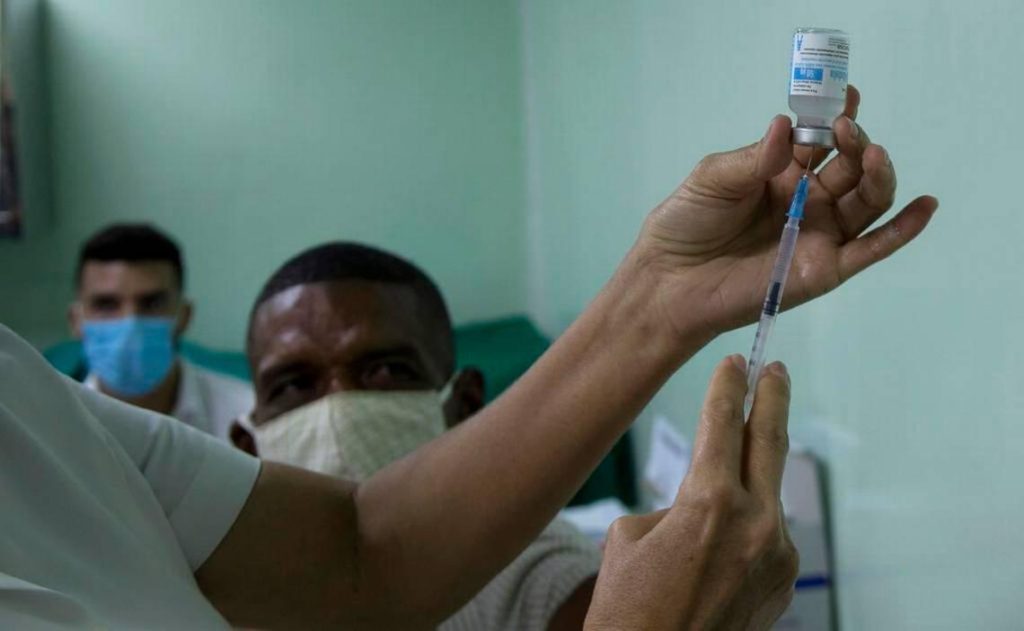[ad_1]
Cuba, which says it has developed five COVID-19 vaccine candidates and immunized about 2 million people in the island of 11 million, apparently didn’t plan for a crucial part of its vaccination campaign: syringes.
As COVID-19 cases have spiked in recent weeks, the lack of syringes looms as a major challenge for the island, where a crushing recession has triggered a food crisis and shortages of medicine and basic necessities. Trump-era sanctions made it harder for Cuba to buy syringes from major manufacturers, which are already swamped with orders from bigger, richer countries.
Making matters worse, some of Cuba’s vaccines require three doses, meaning the Caribbean nation needs more syringes per capita than most countries using the double shots made by Pfizer, Astrazeneca, Moderna and the single-dose jab by Janssen. Cuba is aiming to vaccinate all of Havana’s 2 million population by September and a total of about 10 million people by the end of the year.
When it became clear the island wouldn’t manage on its own, aid organizations in the U.S. and Europe sprang into action. They launched campaigns to collect donations to buy syringes and have them shipped to the island to help narrow a deficit of as many as 25 million syringes.
The response in just little over a month has been “phenomenal,” according to Global Health Partners, a New York-based NGO that’s leading the Saving Lives campaign. Others in Spain, Italy and Latin American nations like Argentina and Honduras have also contributed. Cubans living abroad launched campaigns in cities all over the world, and in Miami a caravan against the U.S. embargo last month also collected local donations.
“I’ve been doing medical aid campaigns to help Cuba for over 20 years and I’ve never seen anything like this,” said executive director Bob Schwartz. He said the organization was initially targeting enough money to buy 3 million syringes, but got such overwhelming support — and $400,000 in donations — that it purchased 4 million and is working to buy another 2 million. He hopes to have them on the ground in Cuba by mid-July. Global Health Partners has a U.S. Commerce Department license to send medical supplies to Cuba.
Story continues
It’s unclear how many syringes Cuba has or needs, but official state media have publicized donations the island has received from countries like France and Argentina.
The island managed to navigate the first waves of the coronavirus pandemic last year thanks to a strict quarantine and a public health system that, although hit by severe shortages in recent years, remains stronger than its counterparts in many of its Caribbean neighbors. But a new wave after Cuba reopened its borders to tourism in November has placed the island near the top of COVID-19 rankings in the region, triggering calls for the government to start mass vaccinations. Health officials began administering the Soberana and Abdala shots last month even before they were approved by Cuba’s drug authority.
COVID-19 cases, which totaled just over 12,200 in all of last year, surpassed 149,000 so far this year. Since the start of the pandemic Cuba has registered about 162,000 cases and 1,118 deaths, according to the World Health Organization. The island hit a record 1,537 new cases on Tuesday before the numbers fell slightly to 1,403 on Wednesday.
Cuban government officials were criticized for not purchasing vaccines to start protecting its population sooner, while it worked on developing its own shots. The socialist regime opted to focus on a homegrown solution that is presumably cheaper and can ensure a provision of lifesaving shots even amid challenges created by the long-standing U.S. embargo. Cuba’s long tradition of vaccine production, a robust biotech industry and critical mass of scientists set it up for success in becoming the first country in Latin America to produce a COVID vaccine.
The island has five vaccines in various stages of clinical trials and aims to produce around 100 million doses this year to export to countries in Latin America and Africa. It has even flagged the possibility of offering vaccines to tourists. And production can continue over the next few years to supply a likely need of booster shots.
But for now, it needs syringes for its own people. Vaccinations in Havana have slowed transmission there, with infection rates falling to around 370 from a peak of about 800 per day a month ago, according to government data. The improvement is partly due to vaccination efforts, said the Heath Ministry’s director of epidemiology, Francisco Durán García, in a daily televised update on Wednesday.
“We need to continue to advance as fast as we can so that we can see what effect [the vaccine] will have, together with prevention measures that the population already knows,” he said.
One group in Miami wants the Cuban American community to contribute to help families on the island get vaccinated. The Caravan for the Cuban Family and the Lifting of the Blockade of Cuba, which has attracted dozens of supporters in cars and bikes to different Miami locations on the last Sunday of every month since July last year, is spreading the word about how people can donate to the syringe efforts, said Carlos Lasso, one of the organizers.
“A lot of people in Miami have family in Cuba, and I’m sure they want their families protected from COVID-19; joining the campaign for syringes is a huge way to help them,” Lasso said.
[ad_2]
Source link
